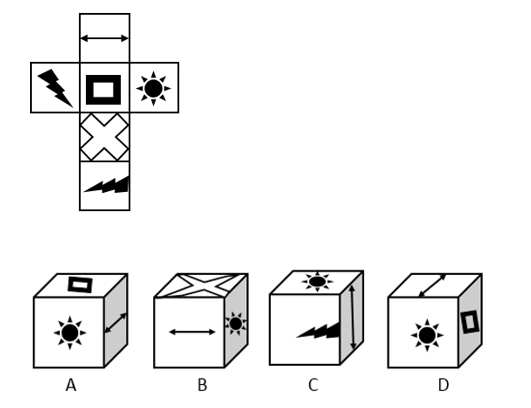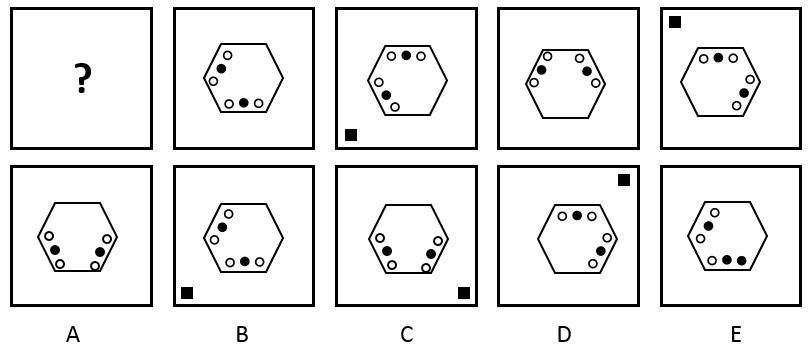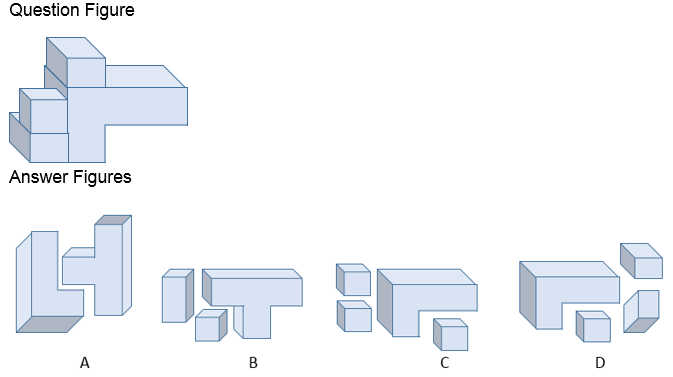The 11 plus test is designed to assess whether year 6 pupils are suitable to progress to Grammar School. The test assesses candidates’ skills in relation to English, Maths, Verbal and Non-Verbal Reasoning. In this blog, we’ll focus on the 11 plus Non-Verbal Reasoning.
What is Non-Verbal Reasoning?
11 plus Non Verbal Reasoning Tests consist of a series of diagrammatic questions, designed to test how well a pupil can analyse visual information, and solve problems by using visual logic.
During your 11 plus Non-Verbal Reasoning assessment, you will experience the following type of questions:
- Identifying which shape is the odd shape out.
- Working out cube nets and how shapes will look when folded.
- Mirror images and reflections.
- Working out which diagram comes next in a sequence.
- Finding 2 identical shapes in a series.
- Rotations and symmetry.
Each 11 plus non-verbal reasoning question typically contains 3 to 5 shapes, along with 3 to 5 answers from which you can choose.
11 Plus Non-Verbal Reasoning Questions
Below we have provided you with a number of sample 11 plus non-verbal reasoning questions, along with some helpful explanations on how to tackle each one.
Reflections and Rotations
Identify the odd one out in the sequence:
 Answer:
Answer: D
Explanation: The arrow is being rotated clockwise around the circle, in the sequence A-C-E, B-D-F etc. Therefore, Figure D is the odd one out because the arrow has been reflected instead of rotated.
Cube Nets
Work out which of the cubes can be made from the cube net:
 Answer:
Answer: A
Explanation: To answer these types of question, you need to fold along the creases of the cube, so that the shapes are on the outside of the cube. Figure B can be ruled out because the arrow and the ‘cross’ sign need to be on opposite sides. Figure C can be ruled out because the ‘sun’ shape would need to be on the right side of the figure. Figure D can be ruled out because the two pointed arrow and the square would need to replace one another. Therefore, the answer is A.
Odd One Out
Which figure is the odd one out?
 Answer:
Answer: E
Explanation: The number of dots should be one less than the number of sides on the shape. Figure E is the odd one out. All of the other figures contain a number of dots that is one less than the number of sides on the larger shape. Figure E has seven sides, and therefore there should be six dots. However, there are only 5.
Sequence Patterns
Which figure completes the sequence pattern?
 Answer:
Answer: C
Explanation: The dots move to one side in a clockwise motion. Every other figure in the sequence contains a black square in the corner of the box. This square moves one corner clockwise.
Figure A can be ruled out because the figure does not contain a black square in the bottom right corner. Figure B can be ruled out because the dots are not in the correct position. They need to be positioned so that the side that is empty and in-between the two lines of dots, is at the bottom. The black square should be in the bottom right corner. Figure D can be ruled out because the side that is empty and in-between the two lines of dots should be at the bottom. The black square should be in the bottom right corner. Figure E can be ruled out because the side that is empty and in-between the two lines of dots should be at the bottom, not bottom left. The figure also needs to contain a black square in the bottom right corner.
Shape Reconfiguration
Work out which 3D shapes from the Answer Figures are needed to create the Question Figure:
 Answer:
Answer: D
Explanation: When answering these questions, pay close attention to what shapes make up the question figure. In this case, the question figure contains an L shape, 2 cuboids of the same length and a cube. Therefore, the answer is D.
Tips For Passing 11 Plus Non-Verbal Reasoning
For many people, the 11 plus non-verbal reasoning tests are extremely difficult. Many candidates will not have experienced any test similar to the non-verbal assessment, and therefore these tests can pose quite a challenge. As with any assessment, the key is in your preparation. Below we have provided you with a list of top tips for passing any 11 plus non-verbal reasoning assessment that you encounter.
- Accuracy. Accuracy is key. You need to remain as accurate as possible to ensure successful marks. That’s why it is important to understand what is being asked. Most people find it difficult to finish all of the questions. These tests are designed to measure your level of accuracy against the speed at which you progress. Never sacrifice quality for quantity.
- Draw out the questions. Try drawing out the questions as you go. Draw out what you think the shape will look like once it is rotated or reflected. This will help you to visualise the answers more clearly.
- Practice. Practice is key. If you struggle with visualising shapes and objects, you may struggle with these tests. The more you practice these tests, the more likely you are to feel comfortable and confident with these types of questions. Remember, practice makes perfect!
- Attention to detail. Pay attention to everything! Count all the sides, angles, colours, shading, line types, sizing, rotations, reflections etc. That way you can determine what is the same and what is different about the sequence. 11 plus non-verbal reasoning papers are all about the tiny details!
- Try out our free tests. Check out our free online psychometric testing and sample questions to ensure that you are fully prepared for your 11 Plus Non-Verbal Reasoning tests.

 Answer: D
Explanation: The arrow is being rotated clockwise around the circle, in the sequence A-C-E, B-D-F etc. Therefore, Figure D is the odd one out because the arrow has been reflected instead of rotated.
Cube Nets
Work out which of the cubes can be made from the cube net:
Answer: D
Explanation: The arrow is being rotated clockwise around the circle, in the sequence A-C-E, B-D-F etc. Therefore, Figure D is the odd one out because the arrow has been reflected instead of rotated.
Cube Nets
Work out which of the cubes can be made from the cube net:
 Answer: A
Explanation: To answer these types of question, you need to fold along the creases of the cube, so that the shapes are on the outside of the cube. Figure B can be ruled out because the arrow and the ‘cross’ sign need to be on opposite sides. Figure C can be ruled out because the ‘sun’ shape would need to be on the right side of the figure. Figure D can be ruled out because the two pointed arrow and the square would need to replace one another. Therefore, the answer is A.
Odd One Out
Which figure is the odd one out?
Answer: A
Explanation: To answer these types of question, you need to fold along the creases of the cube, so that the shapes are on the outside of the cube. Figure B can be ruled out because the arrow and the ‘cross’ sign need to be on opposite sides. Figure C can be ruled out because the ‘sun’ shape would need to be on the right side of the figure. Figure D can be ruled out because the two pointed arrow and the square would need to replace one another. Therefore, the answer is A.
Odd One Out
Which figure is the odd one out?
 Answer: E
Explanation: The number of dots should be one less than the number of sides on the shape. Figure E is the odd one out. All of the other figures contain a number of dots that is one less than the number of sides on the larger shape. Figure E has seven sides, and therefore there should be six dots. However, there are only 5.
Sequence Patterns
Which figure completes the sequence pattern?
Answer: E
Explanation: The number of dots should be one less than the number of sides on the shape. Figure E is the odd one out. All of the other figures contain a number of dots that is one less than the number of sides on the larger shape. Figure E has seven sides, and therefore there should be six dots. However, there are only 5.
Sequence Patterns
Which figure completes the sequence pattern?
 Answer: C
Explanation: The dots move to one side in a clockwise motion. Every other figure in the sequence contains a black square in the corner of the box. This square moves one corner clockwise.
Figure A can be ruled out because the figure does not contain a black square in the bottom right corner. Figure B can be ruled out because the dots are not in the correct position. They need to be positioned so that the side that is empty and in-between the two lines of dots, is at the bottom. The black square should be in the bottom right corner. Figure D can be ruled out because the side that is empty and in-between the two lines of dots should be at the bottom. The black square should be in the bottom right corner. Figure E can be ruled out because the side that is empty and in-between the two lines of dots should be at the bottom, not bottom left. The figure also needs to contain a black square in the bottom right corner.
Shape Reconfiguration
Work out which 3D shapes from the Answer Figures are needed to create the Question Figure:
Answer: C
Explanation: The dots move to one side in a clockwise motion. Every other figure in the sequence contains a black square in the corner of the box. This square moves one corner clockwise.
Figure A can be ruled out because the figure does not contain a black square in the bottom right corner. Figure B can be ruled out because the dots are not in the correct position. They need to be positioned so that the side that is empty and in-between the two lines of dots, is at the bottom. The black square should be in the bottom right corner. Figure D can be ruled out because the side that is empty and in-between the two lines of dots should be at the bottom. The black square should be in the bottom right corner. Figure E can be ruled out because the side that is empty and in-between the two lines of dots should be at the bottom, not bottom left. The figure also needs to contain a black square in the bottom right corner.
Shape Reconfiguration
Work out which 3D shapes from the Answer Figures are needed to create the Question Figure:
 Answer: D
Explanation: When answering these questions, pay close attention to what shapes make up the question figure. In this case, the question figure contains an L shape, 2 cuboids of the same length and a cube. Therefore, the answer is D.
Answer: D
Explanation: When answering these questions, pay close attention to what shapes make up the question figure. In this case, the question figure contains an L shape, 2 cuboids of the same length and a cube. Therefore, the answer is D.